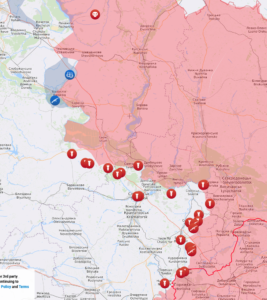Ukraine is expected to receive some F-16 fighter planes…sometime. Like the M1A1 Abrams tanks we’re sending them, the Biden Administration can be frustratingly vague about when they’ll actually get major weapons systems.
But Michael Bohnert at Defense News makes an interesting point: There mere presence of F-16s will force Russian planes to fly more missions. And the old Soviet planes that make up the bulk of Russia’s air forces have much shorter operational lifetimes than Western aircraft.
With F-16 fighter jets expected to be provided to Ukraine over the coming months, opinions of their usefulness spans from a gamechanger in the war with Russia to a total waste of resources. But there is one way that these aircraft will harm Russia even if they never shoot down a missile, fighter jet or helicopter: They will cost the Russian Aerospace Forces precious aircraft life.
The Russian Aerospace Forces, or VKS, possessed roughly 900 tactical aircraft before the 2022 invasion of Ukraine. These included fighter, attack and fighter-bomber aircraft. Since the invasion, it has lost between 84 and 130 of those to air defenses, fighter aircraft and crashes. That’s only a portion of total losses, however. Overuse of these aircraft is also costing Russia as the war drags on.
In a conflict’s early stages, what matters is total combat power from all active platforms; that represents the maximum firepower that can be directed at the opposition from the onset. In a protracted war, where one force tries to exhaust the other, it’s the total longevity of the military force that matters. And that’s where the VKS finds itself now.
By my calculations, the extra hours that it’s pressed its aircraft into service since February 2022 have effectively cost it an additional 27 to 57 aircraft in imputed losses.
Aircraft have a life span. They are designed with a total number of expected flight hours, which are used roughly evenly over the life of the aircraft and segmented with periodic maintenance and inspection. For example, if an aircraft is designed for 3,000 flight hours with an expected use of 30 years, the aircraft will fly roughly 100 hours per year. If, during an inspection, wear on the plane is found to be more or less than expected, the projected remaining hours are adjusted accordingly. These numbers dictate all sorts of planning, from fuel procurement to ground maintenance to pilot training.
Imputed losses mean that the Russians have burned through more of the expected life span of their aircraft more quickly than anticipated. To make up for it, they’ll have to procure more aircraft, increase maintenance, reduce operations, or accept a smaller force — or some combination of those.
The VKS is still in the process of transitioning from Soviet-era aircraft to more modern platforms, and an estimated 18 to 36 of these newer tactical aircraft join the force every year. Almost half of the VKS force is still upgraded Soviet-era airframes.
While newer Russian aircraft are designed for between 3,500 and 4,500 flight hours, with some as high as 6,000, those Soviet-era aircraft were designed to be in the air only 2,000 to 3,500 hours. Although several platforms, such as the MiG-31, have been upgraded to extend their service life, many of these older planes (Su-24, Su-25, Su-27, MiG-29) are nearing the end of their service lives. These have, at best, 500 to 1,000 hours remaining.
In the first few months of the war in Ukraine, the VKS was flying as many as 150 to 300 sorties per day — compared with the peacetime rate of roughly 60 per day. Even dropping to 100 sorties a day since, the VKS has basically flown double its normal annual hours since the beginning of the war.
This extra use is, by commonly used measures, equivalent to losing roughly 34 aircraft since the start of the invasion. However, this only captures the losses relative to the life span of newer airframes. Because the older airframes have so few remaining hours, it’s actually equivalent to losing about 57 VKS airframes.
Add to that the Russian reputation for corruption and lousy maintenance, and you can see how F-16s (and other western planes) could overstress Russia’s air force even without racking up air-to-air kills.
